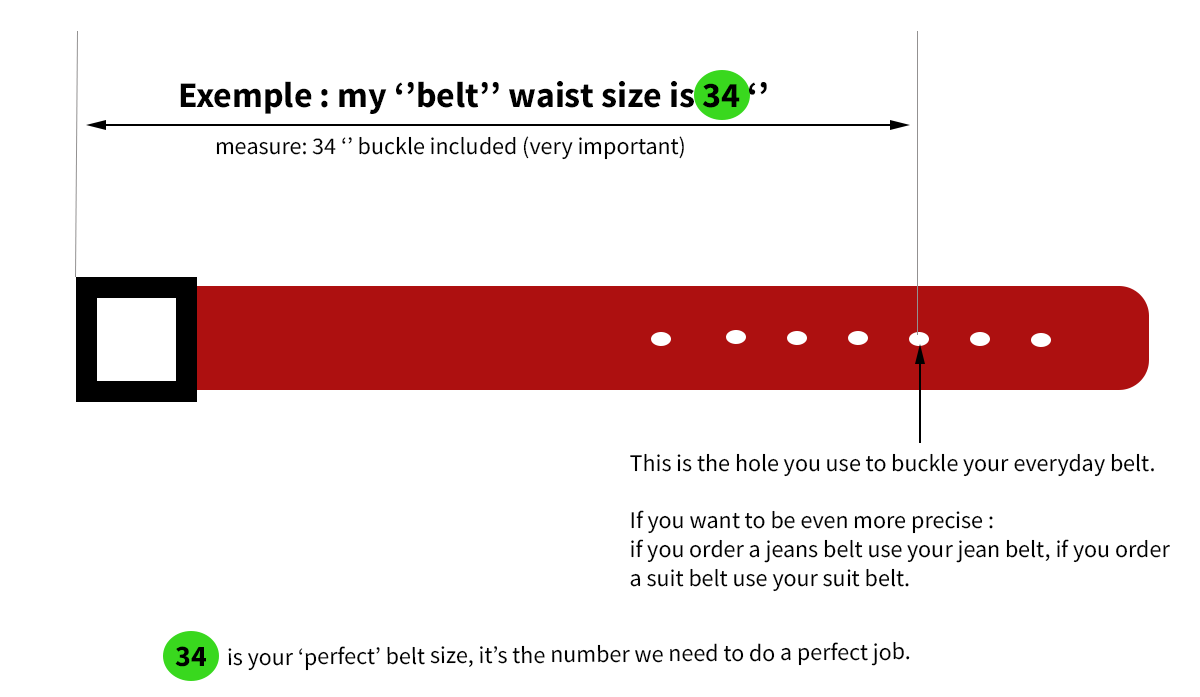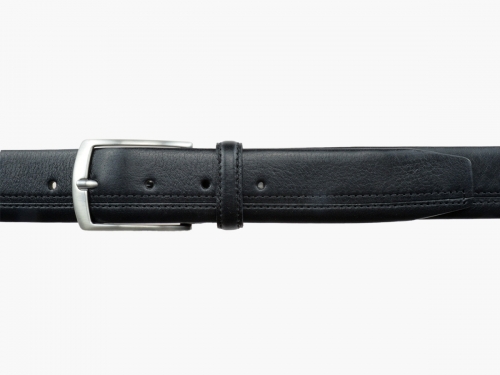- 1 likes
- 867 views
The belt is an often underestimated men everyday accessory. Wrongly, because even if it is not necessarily noticed at first glance, it is important to affirm your style. In addition to its practical aspect (it allows you to hold pants that are slightly loose at the waist), it perfectly completes an outfit.
First of all, you will have to be careful to choose the color of your belt, namely a shade in the same tones as the clothes or the shoes you wear . We will also be careful to choose one that will be adapted to our morphology and our style: type of buckle, length, width and material.
Once well chosen, a good belt will follow you for many years (this is the case for mine which I have had for over ten years). Without further ado, here are some tips for choosing your future belt:
1. Which material to choose for a quality belt?
Before embarking on the purchase of a belt, it must be kept in mind that it must correspond to your style and must adapt easily to your outfits.
Thus, we will of course avoid errors of taste of the type: formal belt in black leather with a cargo pants or conversely, a big buckle wide brown jeans leather belt with a suit. In the same way, the material is to be taken into account. In this sense, it is impossible to wear a cotton belt with a suit, and it is inconsistent to wear a belt that is too formal with casual chinos.
Generally, there are several materials used in belts composition:
- Faux leather / fake leather
Faux leather, also known as synthetic leather, begins with a fabric base such as polyester. The fabric is then given an imitation leather finish and texture with wax, dye, polyvinyl chloride (PVC), or polyurethane.
Watch out, I'm raising the red flag! We find polyurethane (otherwise called imitation leather) on low-end belts, especially at certain fast-fashion brands (I won't name names). In appearance, it looks like leather, but in reality, it is far from a natural product.
Indeed, imitation leather is created from chemical components. Very often sold at low prices, ((sometimes they are expensive because branded, it's clearly theft)) imitation leather belts do not last over time and very often end their short life cracked and torn.
In short, it is the material to avoid if you are looking for a quality and durable belt!
- The leather belt, a reliable material?
Leather is a preferred material for a belt. Of course, you have to be aware that there are different types of leather, but also different degrees of quality.
The price will therefore follow accordingly. In general, the belts found on the market are made of cowhide (Bovine leather) or reversed calfskin (suede - Nubuck). They are found in many variations: smooth, braided, perforated, rawhide or even grained. As with all leather clothing, there are also belts in ostrich, lizard, crocodile and all kinds of more or less exotic animals. Again, prices vary depending on the rarity of the animal (yes, sad to say).
To stay classic, we recommend simply turning to cowhide leather or bull hide leather for jeans belts. Depending on the quality of the leather, the belt will more or less last over time and acquire a brilliant patina over the years.
If you want more information about different type of leather you can check the Wikipedia leather page: leather information.
- And other materials then?
Leather is not the only material that makes up our belts. Very present in the composition of certain clothes (including those of low-end products), polyester is often used for its elasticity. This fiber is also found in certain fabric belts. And quite often, the result is cheap products and poorly durable belts. Polyester, with a low percentage, will allow a braided belt, for example, to gain in elasticity and durability. Be careful, we do not recommend 100% polyester!
Similarly, viscose is a synthetic fiber. It is very often said that viscose imitates the appearance of silk. Coupled with elastane, it is not uncommon to find it in the composition of certain braided belts. Elastane is a synthetic fiber known for its elasticity. It is generally found combined with another material to create stretch fabrics. In the composition of the braided belts, we can find wool or cotton for belts with a casual and relaxed style.
We also find belts in nylon, nylon is very interesting because it allowed to create very strong belt with very cool style, perfect for the summer or to wear in trekking or camping trip.
GAROT N°2 | Dress belt for men | luxurious and modern
GAROT N°4 | Dress belt for men | Unique and very modern
GAROT N°5 | Dress belt for men | Deer leather belt, supple and elegant
GAROT N°6 | Dress belt for men | Every-day in style
GAROT N°7 | Dress belt for men | Papyrus print suit belt, exclusive
2. How to chose the perfect belt size?
Concretely, you must be able to close a belt at the middle hole. Being generally provided with 5 holes, a belt is considered to fit correctly if it tightens enough at the waist to hold the pants without leaving marks at the third hole. Of course, it is possible to close your belt on the 4th or even the 5th hole. And if so, it will be too big, which can be seen aesthetically, but everyone has their own style and some people like to have longer belt and more holes, what is perfectly fine on a jeans, not on a suit.

3. What width should you choose for your belt?
All belts are not the same width, so it is important to have in mind that a belt is usually chosen according to the type of pants you wear. Here, it is the width of the belt that we are going to talk about,we agree that in general, for a formal occasion (worn with a suit for example), a belt should measure between 2.5 and 3.5 cm in width (1 inch and 1.37 inches). Nowadays a 1-inch belt is not very usual, it was very popular in the past with velvet pants. So, for a formal use let’s say that a belt between 1/3-16’’ and 1/3-8’’ is the “standard”.
A larger size would make it too visually imposing compared to the elegance of the pants you are wearing. Conversely, you must be aware that it must still be visible and that a belt that is too thin would give a scruffy look. The aesthetic interest of a belt remains to hide the button, the closure of our pants and to create a break in our silhouette. Beyond 3.5 centimeters, a belt always becomes ideal to wear with jeans, the loops being able to accept up to 5cm (1/31-32’’) in width. According to most of belts designers, the perfect width for a jeans is 1 /1-2 ‘’.
4. What are the different belt styles?
- The classic belts
The classic belt or men's dress belts is the one usually worn with a suit. It is thin, plain, minimalist and in leather. It absolutely must go hand in hand with the outfit you wear, to be elegant.
The formal belt does not attract attention, it just reminds a color present in the outfit in a discreet way. Thus, for maximum discretion and to avoid bad taste, it is recommended to match the color of your belt with that of your shoes. The goal is to distribute the contrasting touches evenly over the silhouette. With a black suit, we will favor a black belt and a silver buckle and black shoes, with a blue suit you can try a camel color belt, with camel shoes, that also works perfectly with dark brown or chestnuts colors.
You can also wear a formal belt with jeans depending on the outfit you have chosen. We are of course talking about a casual “chic” look, such as: a blazer, a white shirt, jeans or chinos and a pair of Derby shoes.
- The "everyday" belt
The casual belt or everyday belt is the one that can be worn for all occasions that do not require wearing a suit. Being wider than a formal belt, it shouldn't be worn with a suit (although that's coming more and more) as it would detract from the elegance of the outfit. This type of belt is therefore easily worn with chinos or jeans and echoes the color of the shoes (in the case of a pair of dress shoes). If shoes are light colored, we will opt for a camel (light brown) tone, if they are dark, we will take a dark brown (or black). In the case of a pair of sneakers in multiple colors, we can move towards a brown leather belt.
Finally, this is not necessarily a general rule, but a light belt with a dark outfit should be avoided because it can create a visually disturbing contrast. There is no "real rule" for casual belts. Just avoid choosing models with too wacky details so as not to take risks. Prefer a simple, plain style with a square or rounded buckle, preferably without a big advertising logo and in classic colors (black, brown, cognac, burgundy, navy).
- The Jeans belt
The Jeans belt is the one that fills the height of your pants loops. Note that the loops of the jeans are quite wide compared to dress pants. Originally, it is above all for practical reasons, in particular so that the jeans of the miners are well maintained with wider leather belts and that they hold effectively.
The jeans belt is essentially made of leather, they are thick and solid, usually with no lining, the best are made with a solid piece of leather just sanded at the back and colored during the tanning process to ensure an unalterable color, with this process the belt is tinted to the heart and not only on the surface. Here again, care must be taken to associate it, as far as possible, with the color of our shoes.
- the braided belt
The models of braided belts are now a basic of the male wardrobe, and have been for a few years. There are some in leather; adding a touch of originality without necessarily compromising on the elegance of an outfit, and in fabric, allowing original color variations during the summer period and in more cheerful outfits. The braided fabric belt is often colored, which allows it to go well with chinos in a casual outfit or simply with jeans. Of course, we will avoid wearing this kind of belt in a suit.
The braided leather belt is an interesting alternative to the casual belt. Often worn in summer, it brings an authentic and vintage look. Again, they are available in various widths and lengths. Its choice will depend on the type of pants with which you want to wear it. We won't dare it with a classic suit, but wearing it with jeans and a blazer can be an option. The rule of color agreement remains however always valid and marrying your belt with your shoes is a safe bet.







